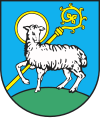Lidzbark Warmiński
| Lidzbark Warmiński | ||
|---|---|---|
 
Panorama of the town (top)
Warmian Bishop's castle (bottom) |
||
|
||
| Coordinates: 54°7′N 20°35′E / 54.117°N 20.583°E | ||
| Country |
|
|
| Voivodeship | Warmian-Masurian | |
| County | Lidzbark | |
| Gmina | Lidzbark Warmiński (urban gmina) | |
| Established | before 1240 | |
| Town rights | 1308 | |
| Government | ||
| • Mayor | Jacek Wiśniowski | |
| Area | ||
| • Total | 14.34 km2 (5.54 sq mi) | |
| Population (2006) | ||
| • Total | 16,390 | |
| • Density | 1,100/km2 (3,000/sq mi) | |
| Time zone | CET (UTC+1) | |
| • Summer (DST) | CEST (UTC+2) | |
| Postal code | 11-100 to 11-102 | |
| Area code(s) | +48 89 | |
| Car plates | NLI | |
| Website | Lidzbark.pl | |
Lidzbark Warmiński [ˈlʲid͡zbarɡ varˈmʲiɲskʲi] (German: Heilsberg (![]() listen)) is a town in the Warmian-Masurian Voivodeship in Poland. It is the capital of Lidzbark County.
listen)) is a town in the Warmian-Masurian Voivodeship in Poland. It is the capital of Lidzbark County.
Lidzbark Warmiński was once the capital of Warmia and formerly its largest city. The city itself was a rich center of faith and culture and was known as the Pearl of Warmia. For a long period of time it was under the control of the Bishops of Warmia and it was also a major economic center, only resigning its importance to the nearby city of Braniewo.
The Warmian Bishop's Castle is considered to be a great artistic and historical value in the world and has been recognised as a historical monument by the Polish government.
The town was originally an Old Prussian settlement known as Lecbarg until being conquered in 1240 by the Teutonic Knights, who named it Heilsberg. In 1306 it became the seat for the Bishopric of Warmia (Ermland), and remained the Prince-Bishop's seat for 500 years. In 1309 the settlement received town privileges. After the Second Peace of Thorn (1466) weakened the Teutonic Order and ended its claim to the area, the town was integrated into the Polish province of Royal Prussia.
...
Wikipedia


